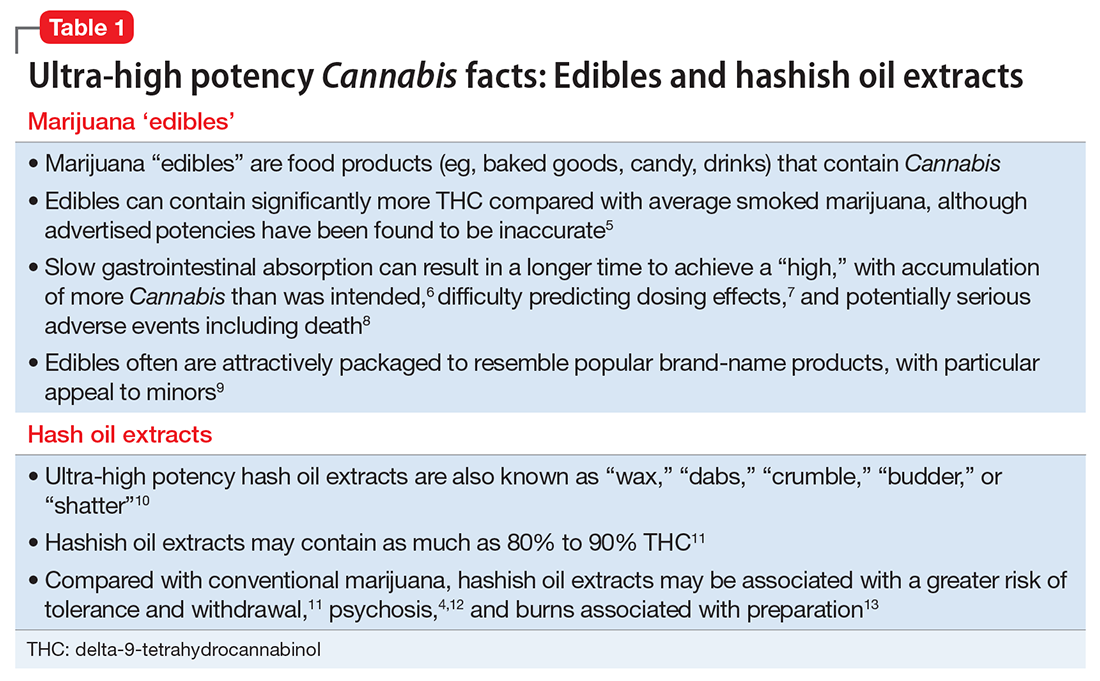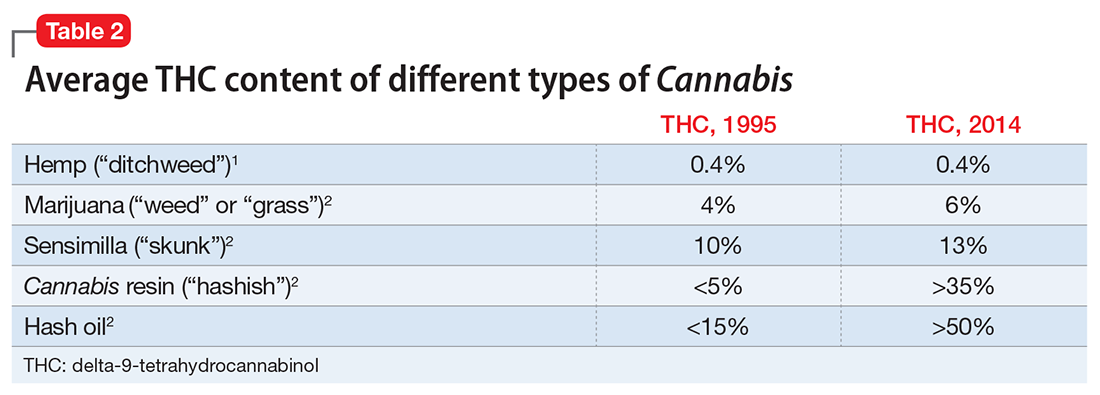1. Mehmedic Z, Chandra S, Slade D, et al. Potency trends of ∆9-THC and other cannabinoids in confiscated cannabis preparations from 1993 to 2008. J Forensic Sci. 2010;55(5):1209-1217.
2. ElSohly MA, Mehmedic Z, Foster S, et al. Changes in cannabis potency over the last 2 decades (1995-2014): analysis of current data in the United States. Biol Psychiatry. 2016;79(7):613-619.
3. Sevigny EL. Is today’s marijuana more potent simply because it’s fresher? Drug Test Anal. 2012;5(1):62-67.
4. Pierre JM, Gandal M, Son M. Cannabis-induced psychosis associated with high-potency “wax dabs.” Schizophr Res. 2016;172(1-3):211-212.
5. Vandrey R, Raber JC, Raber ME, et al. Cannabinoid dose and label accuracy in edible medical cannabis products. JAMA. 2015;313(24):2491-2493.
6. Friese B, Slater MD, Annechino R, et al. Teen use of marijuana edibles: a focus group study of an emerging issue. J Prim Prev. 2016;37(3):303-309.
7. Lamy FR, Daniulaityte R, Sheth A, et al. “Those edibles hit hard”: exploration of Twitter data on cannabis edibles in the U.S. Drug Alcohol Depend. 2016;164:64-70.
8. Hancock-Allen JB, Barker L, VanDyke M, et al. Death following ingestion of an edible marijuana product—Colorado, March 2014. MMWR Morb Mortal Wkly Rep. 2015;64(28):771-772.
9. MacCoun RJ, Mellow MM. Half-baked—The retail promotion of marijuana edibles. N Engl J Med. 2015;372(11):989-990.
10. Stogner JM, Miller BL. Assessing the dangers of “dabbing”: mere marijuana or harmful new trend? Pediatrics. 2015;136(1):1-3.
11. Loflin M, Earleywine M. A new method of cannabis ingestion: the dangers of dabs? Addict Behav. 2014;39(10):1430-1433.
12. Keller CJ, Chen EC, Bodsky K, et al. A case of butane hash oil (marijuana wax)-induced psychosis. Subst Abus. 2016;37(3):384-386.
13. Jensen G, Bertelotti R, Greenhalgh D, et al. Honey oil burns: a growing problem. J Burn Care Res. 2015;36(2):e34-e37.
14. Campos AC, Fogaça MV, Sonego AB, et al. Cannabidiol, neuroprotection and neuropsychiatric disorders. Pharmacol Res. 2016;112:119-127.
15. Gururajan A, Malone DT. Does cannabidiol have a role in the treatment of schizophrenia? Schizophr Res. 2016;176(2-3):281-290.
16. Hasin DS, Saha TD, Kerridge BT, et al. Prevalence of marijuana use disorders in the United States between 2001-2002 and 2012-2103. JAMA Psychiatry. 2015;72(12):1235-1242.
17. Compton WM, Grant BF, Colliver JD, et al. Prevalence of marijuana use disorders in the United States: 1991-1992 and 2001-2002. JAMA. 2004;291(17):2114-2121.
18. van der Pol P, Liebregts N, Brunt T, et al. Cross-sectional and prospective relation to cannabis potency, dosing and smoking behavior with cannabis dependence: an ecological study. Addiction. 2014;109(7):1101-1109.
19. Freeman TP, Morgan CJ, Hindocha C, et al. Just say ‘know’: how do cannabinoid concentrations influence users’ estimates of cannabis potency and the amount they roll in joints? Addiction. 2015;109(10):1686-1694.
20. Freeman TP, Winstock AR. Examining the profile of HPC and its association with severity of cannabis dependence. Psychol Med. 2015;45(15):3181-3189.
21. Gage SH, Hickman M, Zammit S. Association between cannabis and psychosis: epidemiologic evidence. Biol Psychiatry. 2016;79(7):549-556.
22. Marconi A, Di Forti M, Lewis CM, et al. Meta-analysis of the association between the level of cannabis use and risk of psychosis. Schizophr Bull. 2016;42(5):1262-1269.
23. Pierre JM. Cannabis, synthetic cannabinoids, and psychosis risk: what the evidence says. Current Psychiatry. 2011;10(9):49-58.
24. Pierre JM. Psychosis associated with medical marijuana: risk vs. benefits of medicinal cannabis use. Am J Psychiatry. 2010;167(5):598-599.
25. Di Forti M, Morgan C, Dazzan P, et al. HPC and the risk of psychosis. Br J Psychiatry. 2009;195(6):488-491.
26. Di Forti M, Marconi A, Carra E, et al. Proportion of patients in south London with first-episode psychosis attributable to use of high potency cannabis: a case-control study. Lancet Psychiatry. 2015;2(3):233-238.
27. Di Forti M, Sallis H, Allegri F, et al. Daily use, especially of high-potency cannabis, drives the earlier onset of psychosis in cannabis users. Schizophr Bull. 2014;40(6):1509-1517.
28. Schoeler T, Pestros N, Di Forti M, et al. Effects of continuation, frequency, and type of cannabis use on relapse in the first 2 years after onset of psychosis: an observational study. Lancet Psychiatry. 2016;3(10):947-953.
29. Cohen PJ. Medical marijuana: the conflict between scientific evidence and political ideology. Part one of two. J Pain Pall Care Pharmacother. 2009;23(1):4-25.
30. Crean RD, Crane NA, Mason BJ. An evidence-based review of acute and long-term effects of cannabis use on executive cognitive functions. J Addict Med. 2011;5(1):1-8.
31. Volkow N, Swanson JM, Evins E, et al. Effects of cannabis use on human behavior, including cognition, motivation, and psychosis: a review. JAMA Psychiatry. 2016;73(3):292-297.
32. Hart CL, van Gorp W, Haney M, et al. Effects of acute smoked marijuana on complex cognitive performance. Neuropsychopharmacology. 2001;25(5):757-765.
33. Vadhan NP, Hart CL, van Gorp WG, et al. Acute effects of smoked marijuana on decision making, as assessed by a modified gambling task, in experienced marijuana users. J Clin Exp Neuropsychol. 2007;29(4):357-364.
34. Ramaekers JG, Kauert G, van Ruitenbeek P, et al. High-potency marijuana impairs executive function and inhibitory motor control. Neuropsychopharmacology. 2006;31(10):2296-2303.
35. Schreiner AM, Dunn ME. Residual effects of cannabis use on neurocognitive performance after prolonged abstinence: a meta-analysis. Exp Clin Psychopharmacol. 2012;20(5):420-429.
36. Rocchetti M, Crescini A, Borgwardt S, et al. Is cannabis neurotoxic for the healthy brain? A meta-analytical review of structural brain alterations in non-psychotic users. Psychiatr Clin Neurosci. 2013;67(7):483-492.
37. Battistella G, Fornari E, Annoni J, et al. Long-term effects of cannabis on brain structure. Neuropsychopharmacology. 2014;39(9):2041-2048.
38. Gilman JM, Kuster JK, Lee S, et al. Cannabis use is quantitatively associated with nucleus accumbens and amygdala abnormalities in young adult recreational users. J Neurosci. 2014;34(16):5529-5538.
39. Becker MP, Collins PF, Lim KO, et al. Longitudinal changes in white matter microstructure after heavy cannabis use. Dev Cog Neurosci. 2015;16:23-35.
40. Rigucci S, Marques TR, Di Forti M, et al. Effect of high potency cannabis on corpus callosum microstructure. Psychol Med. 2016:46(4):841-854.
41. Cavazos-Rehg PA, Sowles SJ, Krauss MJ, et al. A content analysis of tweets about high-potency marijuana. Drug Alcohol Depend. 2016;166:100-108.
42. Hill KP. Medical marijuana for treatment of chronic pain and other medical and psychiatric problems: a clinical review. JAMA. 2015;313(24):2474-2483.



